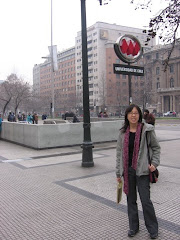So by now it's been a few weeks, and I'm starting to feel "at home". The first few days were about readjusting to the sights, smells and infrastructure of Peru: remembering to put your toilet paper in the little trash can and not in the toilet (most countries' sewage system can't handle it); bargaining with your taxista for the price before getting in; holding your breath while on the road because the exhaust here is terrible, yet most Peruvian drivers like to keep their windows rolled all the way down. (Well, sometimes this serves a practical purpose; several times I've taken cabs whose inner door latch was broken, so you had to reach outside the window to open your door from the outside. More on Peru's exciting transportation options in a future blog.)
Other subtle differences: the dimmer light bulbs (which dim further when you turn on any electric appliance); the ambient noise (the trashman's bell, the high-pitched taxi horns, and in the poorer neighborhoods, roosters crowing and stray dogs barking); and the dust that is everywhere in Trujillo.
However, this is my fourth time in Peru and my tenth time in a developing country, so it hasn't been hard to adjust to these differences. The fact is, if you're willing to accept a little more grit and less access to consumer goods in your daily life, then living in a place like Trujillo, Peru is very functional. It's a mid-sized city of about 1 million, with a small Spanish colonial center surrounded by middle-class neighborhoods, which are in turn ringed by very large dusty squattervilles. It's got poverty, and a few street kids, but not what I would describe as slums or extreme poverty. It's really not a bad place to live.
The mission does not use any cars, but one has many affordable options for getting around town. The markets offer a decent selection of groceries; I've even found sesame oil. And by now I've located the town's post office (a bit bureaucratic and confusing), movie theater (variable picture and sound quality, but they show Pirates 3 in both dubbed Spanish AND English with subtitles!), department store, appliance store, local video store and takeout options. All I have left to do is figure out where to work out and get my hair cut.
My monthly stipend or "salary", and living costs, are both about 20-25% of what they were in New York. Peru's currency, the Nuevo Sol (s/) is about 3.12 to a $, but the purchasing power of a sol is about the same as a $ in the US.* So for example a coffee is about s/1.5, a movie is s/7, a soda about s/2, a prescription of antibiotic about s/15. It's like being in the US, except you're only spending 30 cents on the $. It feels really good to be spending so little, and therefore needing so little.
*Note: it is not politically correct in Latin America to refer to the United States as "America". Technically all of North and South America is America. So we use "los Estados Unidos" or EE.UU to refer to the US, and the even-harder-to-say "estadounidense" to refer to someone from the US.

The Plaza de Armas in old Trujillo

Typical street corner, with construction, street vendors and political graffiti (this picture was taken last year just before Alan Garcia was elected president)

The Pan American Highway, which runs through Trujillo, with a good representation of local transport vehicles

No comments:
Post a Comment